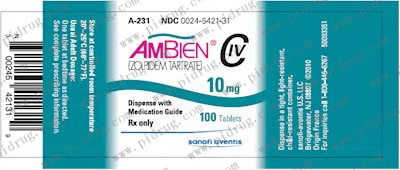Ambien(Zolpidem)
Zolpidem, sold under the brand name Ambien, among others, is a medication primarily used for the short term treatment of sleeping problems.[3][4] Guidelines recommend that it be used only after counseling and behavioral changes have been tried.[5][6][7] It decreases the time to sleep onset by about 15 minutes and at larger doses helps people stay asleep longer.[2] It is taken by mouth and is available in conventional tablets or sublingual tablets and oral spray.[3]
Common side effects include daytime sleepiness, headache, nausea, and diarrhea.[3] Other side effects include memory problems, hallucinations, and abuse.[2] The recommended dose was decreased in 2013 due to next-morning impairment.[8] Additionally, driving the next morning is not recommended with either higher doses or the long-acting formulation.[8] While flumazenil can reverse zolpidem's effects, usually supportive care is all that is recommended in overdose.[9]
Zolpidem is a nonbenzodiazepine and hypnotic of the imidazopyridine class.[3] Zolpidem is a type A GABA receptor agonist.[3] It works by increasing GABA effects in the central nervous system by binding to GABAA receptors at the same location as benzodiazepines.[3] It generally has a half-life of two to three hours.[3] This, however, is increased in those with liver problems.[3]
Zolpidem was approved for medical use in the United States in 1992.[3] It became available as a generic medication in 2007.[10] In the United States it has a monthly cost of about US$8 for immediate release and US$66 for controlled release medication, as of 2017.[2] Zolpidem is a Schedule IV controlled substance under the Controlled Substances Act of 1970 (CSA).[2]More than 10 million prescriptions are filled a year in the United States, making it one of the most commonly used treatments for sleeping problems.[11][12]
Medical uses
Zolpidem is labelled for short-term (usually about two to six weeks) treatment of insomnia at the lowest possible dose.[3][4] It may be used for both improving sleep onset and staying asleep.[2]
Guidelines from NICE, the European Sleep Research Society, and the American College of Physicians recommend medication for insomnia (including possibly zolpidem) only as a second line treatment after nonpharmacological treatment options (e.g. cognitive behavioral therapy for insomnia).[5][6][7] This is based in part on a 2012 review which found that zolpidem's effectiveness is nearly as much due to psychological effects as to the medication itself.[13]
A lower-dose version (3.5 mg for men and 1.75 mg for women) is given as a tablet under the tongue and used for middle-of-the night awakenings. It can be taken if there are at least 4 hours between the time of administration and when the person must be awake.[14]
Contraindications
Zolpidem should not be taken by people with obstructive sleep apnea, myasthenia gravis, severe liver disease, respiratory depression, children, or people with psychotic illnesses. It should not be taken by people who are or have been addicted to other substances.[4]
Use of zolpidem may impair driving skills with a resultant increased risk of road traffic accidents. This adverse effect is not unique to zolpidem but also occurs with other hypnoticdrugs. Caution should be exercised by motor vehicle drivers.[4] In 2013 the FDA recommended the dose for women be reduced and that prescribers should consider lower doses for men due to impaired function the day after taking the drug.[15][16]
Zolpidem should not be prescribed to older people, who are more sensitive to the effects of hypnotics including zolpidem and are at an increased risk of falls and adverse cognitive effects.[17][18]
Zolpidem has been assigned to pregnancy category C by the FDA. Animal studies have revealed evidence of incomplete ossification and increased postimplantation fetal loss at doses greater than seven times the maximum recommended human dose or higher; however, teratogenicity was not observed at any dose level. There are no controlled data in human pregnancy. In one case report, zolpidem was found in cord blood at delivery. Zolpidem is recommended for use during pregnancy only when benefits outweigh risks. [19]
Adverse effects
The most common adverse effects of short-term use include headache (reported by 7% of people in clinical trials), drowsiness (2%), dizziness (1%), and diarrhea (1%); the most common side effects of long-term use included drowsiness (8%), dizziness (5%), allergy (4%), sinusitis (4%), back pain (3%), diarrhea (3%), drugged feeling (3%), dry mouth (3%), lethargy (3%), sore throat (3%), abdominal pain (2%), constipation (2%), heart palpitations (2%), lightheadedness (2%), rash (2%), abnormal dreams (1%), amnesia (1%), chest pain (1%), depression (1%), flu-like symptoms (1%), and sleep disorder (1%).[20]
Zolpidem increases risk of depression, falls and bone fracture, poor driving, suppressed respiration, and has been associated with an increased risk of death.[21] Upper and lower respiratory infections are also common (experienced by between 1 and 10% of people).[4]
Residual 'hangover' effects, such as sleepiness and impaired psychomotor and cognitive function, may persist into the day following nighttime administration. Such effects may impair the ability of users to drive safely and increase risks of falls and hip fractures.[9][22] Around 3% of people taking zolpidem are likely to break a bone as a result of a fall due to impaired coordination caused by the drug.[23]
Some users have reported unexplained sleepwalking while using zolpidem, as well as sleep driving, night eating syndrome while asleep, and performing other daily tasks while sleeping.[9] Research by Australia's National Prescribing Service found these events occur mostly after the first dose taken, or within a few days of starting therapy.[24] In February 2008, the Australian Therapeutic Goods Administration attached a boxed warning concerning this adverse effect.[25]
Overdose
Overdose can lead to coma or death.[4] When overdose occurs, there are often other drugs in the person's system.[4][9]
Zolpidem overdose can be treated with the benzodiazepine receptor antagonist flumazenil, which displaces zolpidem from its binding site on the benzodiazepine receptor to rapidly reverse the effects of the zolpidem. It is unknown if dialysis is helpful.[4]
Mechanism of action
Zolpidem is a ligand of high-affinity positive modulator sites of GABAA receptors, which enhances GABAergic inhibition of neurotransmission in the central nervous system. It selectively binds to α1 subunits of this pentameric ion channel. Accordingly, it has strong hypnotic properties and weak anxiolytic, myorelaxant, and anticonvulsant properties.[35] Opposed to diazepam, zolpidem is able to bind to binary αβ GABA receptors, where it was shown to bind to the α1–α1 subunit interface.[36] Zolpidem has about 10-fold lower affinity for the α2- and α3- subunits than for α1, and no appreciable affinity for α5 subunit-containing receptors.[37][38] ω1 type GABAAreceptors are the α1-containing GABAA receptors and are found primarily in the brain, the ω2 receptors are those that contain the α2-, α3-, α4-, α5-, or α6 subunits, and are found primarily in the spine. Thus, zolpidem favours binding to GABAA receptors located in the brain rather the spine.[39] Zolpidem has no affinity for γ1 and γ3 subunit-containing receptors and, like the vast majority of benzodiazepine-like drugs, it lacks affinity for receptors containing α4 and α6.[40] Zolpidem modulates the receptor presumably by inducing a receptor conformation that enables an increased binding strength of the orthosteric agonist GABA towards its cognate receptor without affecting desensitization or peak currents.[41]
Like zaleplon, zolpidem may increase slow wave sleep but cause no effect on stage 2 sleep.[42] A meta-analysis that compared benzodiazepines against nonbenzodiazepines has shown few consistent differences between zolpidem and benzodiazepines in terms of sleep onset latency, total sleep duration, number of awakenings, quality of sleep, adverse events, tolerance, rebound insomnia, and daytime alertness.[43]



